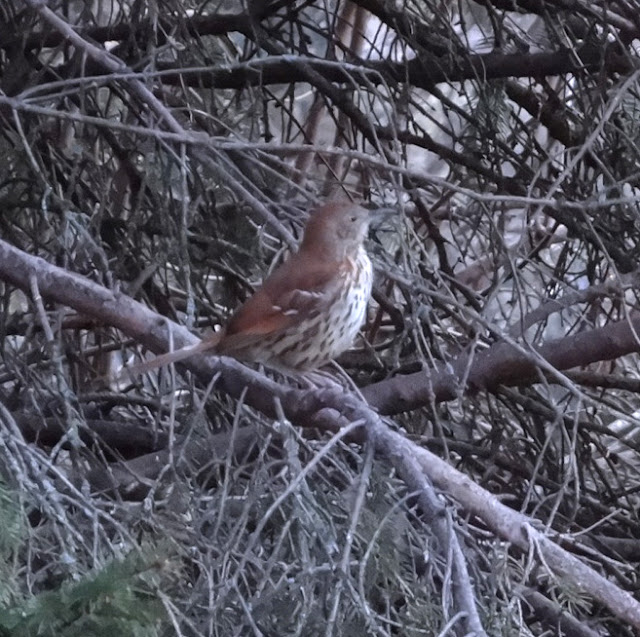Lots of birds migrate at night, especially during a full moon. The light of the moon guides their way. And they're protected from most predators at night.
We know they migrate at night because we see them and hear their songs in the morning, where they weren't there the day before. Plus, those who study bird migration have long-known about night-time migration of many birds by capturing birds in nets -- primarily at night -- for monitoring and banding.
After last night's full moon, we've heard and seen Brown Thrashers, Tree Swallows, White Throated Sparrows, White Crowned Sparrows, Chipping Sparrows and Bluebirds! These have joined the really early migrants that got caught in our late spring snowstorms in April: Red-winged Blackbirds, Fox Sparrows, Grackles and Robins.
Here's a photo of a Brown Thrasher taken last evening. It was trying to get suet out of the feeder. They're hungry after a long flight to get here.
 |
| Brown Thrasher |
Here's a video we took last year of a male Brown Thrasher singing in our garden:
We're always so happy to hear the twittering of the Tree Swallows as they fly like dolphins in the sky around the pasture. Pairs of these acrobatic birds go from birdhouse to birdhouse as they establish their territory, renew mating bonds and claim a nestbox. They line their nests with feathers. If you're patient and lucky, sometimes you can offer them feathers by throwing them up in the air. They'll swoop in a grab the feather in their mouth and fly off. It's an amazing experience -- try it!
 |
| A Tree swallow on a nest box |
Another beautiful bird that nests in birdhouses in the pasture is the beloved Bluebird. They have a sweet, faint call that reminds me of a Robin call. Actually, they're related! These birds really need our help, so providing nest boxes really makes a difference in their population. Be sure to keep the box protected from predators and monitor them throughout the summer. They'll raise two clutches of babies each summer here in Wisconsin.
 |
| Bluebird |
We've also heard the first Chipping Sparrow. I got a glimpse of him this morning as he was announcing his arrival. They nest in our rose bushes and make a grass-lined nest a few feet off the ground. They'll also nest a few times each summer and raise batches of babies. We regularly check the nests for Cowbird eggs to ensure that the little "Chippies" don't end up raising a parasitic Cowbird instead of their own babies!
 |
| Chipping Sparrow |
And one of our favorite migrants is the White Throated Sparrow. It stops at our gardens for about two weeks each spring and fall on its migration north and then south. I can't wait to hear their song, which sounds like "Old Man Peabody, Peabody, Peabody."
 |
| White Throated Sparrow |
To learn more about bird migration and the birds we've highlighted on this posting, be sure to check out All About Birds at Cornell University. It's a great resource for those who want to learn more about their backyard birds!




